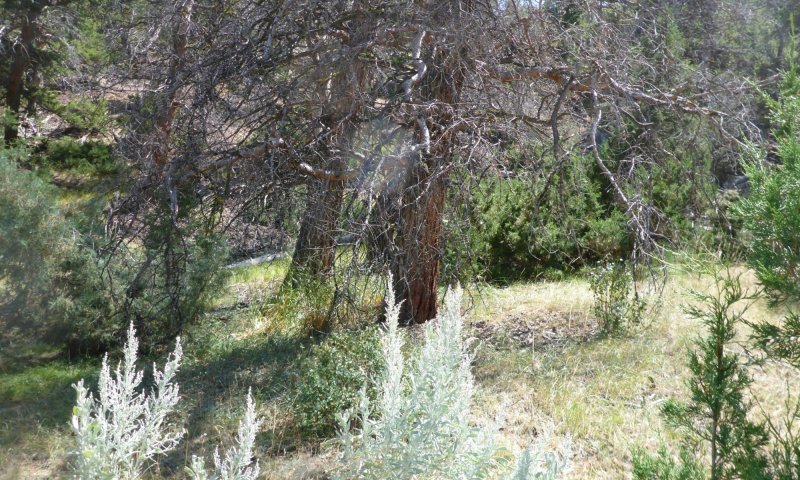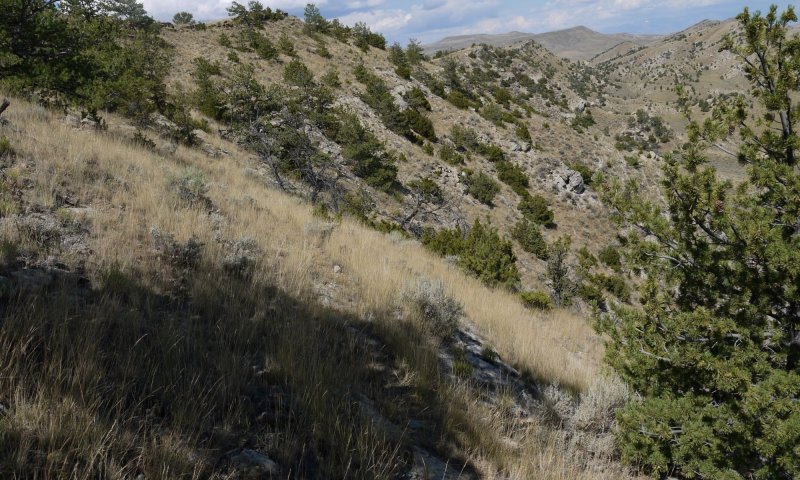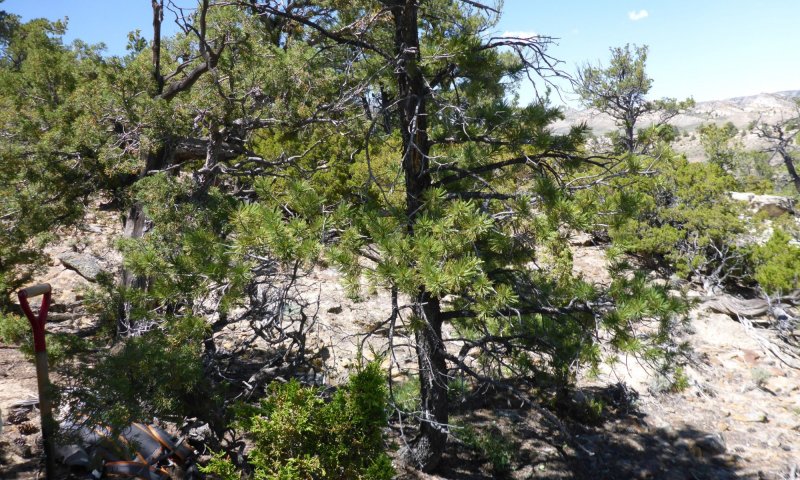Ecological dynamics
The lower mountain slopes and foothills provide a warmer band of forested pockets that are dominated by limber pine, rocky mountain juniper, and some cover of Douglas-fir. Although these communities can have dense over story cover, the herbaceous under story is more common. Variability across the broad extent of this ecological grouping is great within species diversity and timber and forage production.
State 1
Reference
The Reference State for the Shallow Warm Woodland has a Limber pine overstory with native bunchgrasses and shrubs in present in the under story.
Characteristics and indicators. This limber pine dominated site is commonly accompanied by rocky mountain juniper and a low occurrence of Douglas-fir. The under story is comprised of bluebunch wheatgrass, Idaho fescue, threadleaf and needleleaf sedge as well as sandberg bluegrass. Common shrubs are currant, skunkbush, mahogany, and creeping juniper. Arrowleaf Balsamroot, Indian paintbrush, phlox, and cactus are common on this site as well.
Resilience management. The fire frequency on this state is low, however, it does play a role in maintaining limber pine as the dominant over story and controlling the density of rocky mountain juniper on this site.
Dominant plant species
-
limber pine (Pinus flexilis), tree
-
Rocky Mountain juniper (Juniperus scopulorum), tree
-
Douglas-fir (Pseudotsuga menziesii), tree
-
currant (Ribes), shrub
-
mountain mahogany (Cercocarpus), shrub
-
sumac (Rhus), shrub
-
bluebunch wheatgrass (Pseudoroegneria spicata), grass
-
Idaho fescue (Festuca idahoensis), grass
-
threadleaf sedge (Carex filifolia), grass
-
arrowleaf balsamroot (Balsamorhiza sagittata), other herbaceous
-
Indian paintbrush (Castilleja), other herbaceous
-
phlox (Phlox), other herbaceous
Dominant resource concerns
-
Sheet and rill erosion
-
Classic gully erosion
-
Aggregate instability
-
Plant structure and composition
-
Terrestrial habitat for wildlife and invertebrates
-
Inadequate livestock water quantity, quality, and distribution
Community 1.1
Limber pine/Bunchgrasses/Douglas-fir

Figure 8. Image of a PIFL2 dominated community, current canopy impacted by insects, in process of transitioning to the 2.1 community.
The Reference Community (1.1) is a limber pine community with a bluebunch wheatgrass and Idaho fescue under story. Low composition of Rocky mountain juniper and Douglas-fir are also found in this community. Shrubs, including currant, sumac (skunkbush), and mountain mahogany, are common. Arrowleaf baslamroot, a variety of paintbrush species, as well as phlox are found in the under story.
Resilience management. This site is resilient, and fire plays a role in the health and management of the timber. However, with increased fire frequency or intensity, this site can be pushed out of balance. The risk of juniper encroachment and cheatgrass are significant factors to the stability of this site.
Dominant plant species
-
limber pine (Pinus flexilis), tree
-
Douglas-fir (Pseudotsuga menziesii), tree
-
Rocky Mountain juniper (Juniperus scopulorum), tree
-
currant (Ribes), shrub
-
sumac (Rhus), shrub
-
mountain mahogany (Cercocarpus), shrub
-
bluebunch wheatgrass (Pseudoroegneria spicata), grass
-
Idaho fescue (Festuca idahoensis), grass
-
spike fescue (Leucopoa kingii), grass
-
arrowleaf balsamroot (Balsamorhiza sagittata), other herbaceous
-
Indian paintbrush (Castilleja), other herbaceous
-
phlox (Phlox), other herbaceous
State 2
Degraded Overstory
The loss of woody canopy cover due to fire or disease characterizes the transition from the reference state to State 2 - Degraded Overstory.
Characteristics and indicators. Native grasses and grass-likes are dominant on this site. The woody canopy is reduced to cover of less than 15%, and may represent only one or two species. Following disease or other impacts to limber pine, juniper may be come dominant on the site. Bluebunch wheatgrass, Idaho fescue, threadleaf sedge, and sandberg bluegrass are the major grass/grass-like species with arrowleaf balsamroot, indian paintbrush, phlox and cactus.
Resilience management. The herbaceous cover is resistant to change and resilient. Fire is a risk and also a factor to control juniper encroachment.
Dominant plant species
-
Rocky Mountain juniper (Juniperus scopulorum), tree
-
Douglas-fir (Pseudotsuga menziesii), tree
-
currant (Ribes), shrub
-
common snowberry (Symphoricarpos albus), shrub
-
mountain big sagebrush (Artemisia tridentata ssp. vaseyana), shrub
-
bluebunch wheatgrass (Pseudoroegneria spicata), grass
-
Idaho fescue (Festuca idahoensis), grass
-
sedge (Carex), grass
-
arrowleaf balsamroot (Balsamorhiza sagittata), other herbaceous
-
Indian paintbrush (Castilleja), other herbaceous
-
phlox (Phlox), other herbaceous
Dominant resource concerns
-
Sheet and rill erosion
-
Plant productivity and health
-
Plant structure and composition
-
Terrestrial habitat for wildlife and invertebrates
Community 2.1
Native Bunchgrasses/Rocky Mountain juniper/Douglas-fir

Figure 9. Remnants of woody cover evident, but the bunchgrasses and shrubs are dominant in this community.
As the limber pine canopy is reduced by insect, disease, decadence or fire, the under story transitions to a more bunchgrass dominated community with remnants of woody vegetation. As this community progresses, Rocky mountain juniper can become dominant.
Resilience management. Fire management, to allow limber pine to recover, as well as management of junipers is needed to allow this site to maintain or to recover to the Reference state.
Dominant plant species
-
Rocky Mountain juniper (Juniperus scopulorum), tree
-
Douglas-fir (Pseudotsuga menziesii), tree
-
common snowberry (Symphoricarpos albus), shrub
-
currant (Ribes), shrub
-
mountain big sagebrush (Artemisia tridentata ssp. vaseyana), shrub
-
bluebunch wheatgrass (Pseudoroegneria spicata), grass
-
Idaho fescue (Festuca idahoensis), grass
-
sedge (Carex), grass
-
arrowleaf balsamroot (Balsamorhiza sagittata), other herbaceous
-
Indian paintbrush (Castilleja), other herbaceous
-
phlox (Phlox), other herbaceous
State 3
Degraded Understory
The Degraded Understory State is a result of the loss of the native bunchgrasses and the establishment of invasive and aggressive species.
Characteristics and indicators. As bluebunch wheatgrass and Idaho fescue are removed from the community, sandberg bluegrass, prairie junegrass, and threadleaf sedge maintain a footprint. With drought, soil disturbance or in the removal of further understory, invasive species such as cheatgrass can take a hold in the community.
Resilience management. Once invasive species have established, the community is at risk of further degradation, and management at the current community is difficult due to the increased risk of fire and loss of site stability. Loss of the limber pine community or the general increase of Rocky mountain juniper further increases the limitations of this community.
Dominant plant species
-
limber pine (Pinus flexilis), tree
-
Rocky Mountain juniper (Juniperus scopulorum), tree
-
Douglas-fir (Pseudotsuga menziesii), tree
-
currant (Ribes), shrub
-
sumac (Rhus), shrub
-
mountain mahogany (Cercocarpus), shrub
-
Sandberg bluegrass (Poa secunda), grass
-
prairie Junegrass (Koeleria macrantha), grass
-
cheatgrass (Bromus tectorum), grass
-
arrowleaf balsamroot (Balsamorhiza sagittata), other herbaceous
-
phlox (Phlox), other herbaceous
-
plains pricklypear (Opuntia polyacantha), other herbaceous
Dominant resource concerns
-
Sheet and rill erosion
-
Aggregate instability
-
Plant productivity and health
-
Plant structure and composition
-
Wildfire hazard from biomass accumulation
-
Terrestrial habitat for wildlife and invertebrates
-
Feed and forage imbalance
-
Inadequate livestock shelter
Community 3.1
Limber pine/Invasives

Figure 10. The overall lack of under story, with the major species persisting being cheatgrass puts this community at risk.
The limber pine, Rocky mountain juniper, and Douglas-fir over story remains in varying composition, while the under story degrades with increased disturbance, drought, or possibly fire. As the under story degrades, invaders increase in the community. Cheatgrass is the main threat in this system. Rocky mountain juniper can also be an invader in this system.
Resilience management. The increased threat of fire with a cheatgrass under story or increased juniper puts this community and state at risk. However, the community is relatively resilient to change and is difficult to improve due to the aggressive behavior of both cheatgrass and junipers.
Dominant plant species
-
Rocky Mountain juniper (Juniperus scopulorum), tree
-
Douglas-fir (Pseudotsuga menziesii), tree
-
currant (Ribes), shrub
-
sumac (Rhus), shrub
-
mountain mahogany (Cercocarpus), shrub
-
Sandberg bluegrass (Poa secunda), grass
-
threadleaf sedge (Carex filifolia), grass
-
cheatgrass (Bromus tectorum), grass
-
phlox (Phlox), other herbaceous
-
plains pricklypear (Opuntia polyacantha), other herbaceous
-
arrowleaf balsamroot (Balsamorhiza sagittata), other herbaceous
Transition T1A
State 1 to 2
The impacts of wildfire or controlled burns, insect impacts or disease, can weaken and remove the timber cover leaving a herbaceous dominated community.
Constraints to recovery. The shallow soils, change in hydrologic factors with the loss of canopy cover and instability in the soils with loss of cover are constraints to the recover of this site. The viability of limber pine to rejuvenate on the site is also a constraint to recovery. The type and severity of disturbance influences the ability for the timber to re-establish.
Context dependence. This transition could be viewed as a transition between community phases rather than states. However, due to the time of recovery and the tenancy to transition to a less desirable community, this transition is being expressed as states.
Transition T1B
State 1 to 3
Low intensity fire, or soil and canopy disturbances that impacts the under story, open the community to threat of invasion by invasive species. When seed sources are present or are introduced by wind, wildlife, livestock or recreation, this site is easily transitioned to a degraded under story community.
Constraints to recovery. The inability to control invasive species, especially with an existing canopy of woody species, and the ability to encourage native species is difficult with slopes limits the ability of this site to recover.
Restoration pathway R2A
State 2 to 1
Recovery time of a disturbed site is key to allowing the re-establishment of the key species on this site. Integrated management to reduce threats of invasive or undesirable species and promoting propagation of the desired species may be needed depending on the extent of the disturbance. This restoration is part of a natural process in the recovery on a site post fire. However, with the risk of invasive species and the potential for increased fire frequency, fuel load reductions, patch burns or other management techniques may be needed to prevent this site from transitioning to a degraded under story.
Context dependence. The condition of the stand before disturbance, the species of concern in the area pre-disturbance and the impacts following disturbance are factors affecting the ability to recover. Seeding and plantings, erosion control may be necessary to stabilize the site to aid in the restoration process.
| Critical Area Planting |
|
| Mulching |
|
| Integrated Pest Management (IPM) |
|
| Upland Wildlife Habitat Management |
|
| Forest Stand Improvement |
|
| Forest stand improvement for habitat and soil quality |
|
| Forest stand improvement pre-treating vegetation and fuels |
|
| Forest Stand Improvement, Prescribed burning |
|
| Forest Stand Improvement for Soil Quality |
|
| Forest stand improvement pre-treating vegetation and fuels preceding a prescribed fire |
|
Transition T2A
State 2 to 3
Fire or other canopy and soil disturbance opens this site to the threat of invasive species, primarily cheatgrass. In communities that have lost significant limber pine cover, and those that have severe juniper encroachment, are at risk of weed invasion following burns due to the intensity of fire and the lack of cover to maintain the site.
Constraints to recovery. The difficulty to eradicate or manage invasive species, especially on steeper slopes, limits the ability for this site to recover. Lack of soil depth, and slope again, are constraints on this site.





